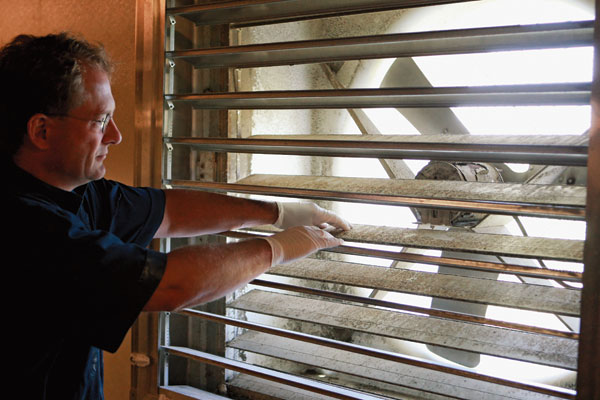In his southern Minnesota practice where hog density is an issue, he oversees a database of filtered sow farms. Seventy-two sow farms have been filtered for at least six months. These farms pretty consistently break with PRRS at a rate of about 5% per year due to a variety of causative factors and biosecurity breaches.

Air filtration systems have become the final piece of the biosecurity puzzle, and are being implemented increasingly in sow farms to protect them from repeated outbreaks of porcine reproductive and respiratory syndrome (PRRS) in swine-dense regions of the United States, according to Darwin Reicks, DVM, Swine Vet Center, St. Peter, MN.
“There is really no magic as to how filters work. They simply capture particles that get caught in the fibers of the filters,” Reicks explained in a talk at the Leman Swine Conference in September in St. Paul, MN.
In his southern Minnesota practice where hog density is an issue, he oversees a database of filtered sow farms. Seventy-two sow farms have been filtered for at least six months. These farms pretty consistently break with PRRS at a rate of about 5% per year due to a variety of causative factors and biosecurity breaches.
“Those same farms before filtration were breaking at a rate of about 68%, but with filtration this is an 85% reduction, so it really does pay for itself,” he maintains.
Minnesota Study
Scott Dee, DVM, also reported at the Leman conference on the results of a field study to test the efficacy of filtering incoming air as a means of reducing the risk of airborne transport of the PRRS virus. The virus has been documented to travel by air from 3-5 miles. Dee conducted the study while at the University of Minnesota. Recently, he has joined the Pipestone (MN) Veterinary Clinic.
The study involved 10 treatment herds and 30 control herds and was conducted over a 36-month period (September 2008 to August 2011).
Herds selected were required to have a breeding inventory of 2,400 sows or more and needed to be surrounded by four or more growing pig sites within a 10-mile radius. The candidate herd also had to have experienced a minimum of three external PRRS infections over the past four years, despite the use of industry standard biosecurity practices, Dee explains.
A summary of characteristics of study herds is provided in Table 1. On a monthly basis, those treatment and control herds were assessed for clinical evidence of PRRS. Blood/oral fluid samples were collected from 30 piglets at weaning and tested by polymerase chain reaction (PCR). If positive, the PRRS strain was compared to historical PRRS strains on that farm, he points out.
Over the 36-month period, eight treatment herds (filtered farms) remained free of infection. However, two herds became infected due to documented breaches detected in transport and personnel biosecurity protocols.
In contrast, 28 of 30 control herds were reinfected with new strains of PRRS, Dee says. Of the 28 farms, 17 (62%) were infected once, seven (25%) were infected twice and four (13%) were infected three times.
“These results suggest that air filtration is an effective means to reduce the risk of external PRRS virus introduction to large breeding herds located in swine-dense regions,” he states.
Studies are currently underway to continue assessing the sustainability of air filtration and calculate its cost:benefit ratio. If proven efficacious over time, sustained freedom from PRRS virus in swine-dense regions will become a reality, Dee notes.
“Sustainability and financial benefit are the two big questions that everyone has with filtration — will it work and will it pay? The answer to both of these questions is clearly yes,” he remarks.
Cost Analysis
Reicks and Dale Polson, DVM, Boehringer Ingelheim Vetmedica, Inc. used a net present value (NPV) model to assess the long-term financial impact of site-level air filtration. NPV is defined as the difference between the present value of cash inflows and the present value of cash outflows.
A commercial spreadsheet was used to run the stochastic (random variable) NPV model template, taking into consideration filtration cost, pig performance and margin-over-variable costs. Two basic breeding farm sites were compared, one with conventional ventilation, the other tunnel ventilated. Installation and operating costs depend on whether the filtration system will operate year-round or partial (seasonal), and whether normal- or high-flow filters are installed.
According to Reicks, the average air filtration installation cost per breeding space was $150 for full air filtration at normal ventilation rates and $200 for full air filtration in a tunnel-ventilated system.
The estimated pre-filter replacement cost/breeding space was $2.25.Estimated filter replacement cost per breeding space was $64/year for both full filtration, conventionally ventilated and for full filtration in a tunnel-ventilated system.
Pre-filter replacement interval was estimated at twice per year for both systems modeled, on average, and an average of four times per year for filter replacement of the two systems modeled.
Using data compiled from actual filtered farms, Reicks calculated that 92% of sow farms broke with PRRS infection per year before full filtration (essentially one break every year), but only 16% broke per year after installing full filtration (or one break every 6+ years).
Using Reicks’ filtration cost estimates, the non-discounted cost to install and maintain full air filtration in a sow farm was calculated at $40.93/sow/year over a 10-year period for a conventional ventilation scenario, and $52.66/sow/year for a tunnel-ventilated scenario over 10 years.
The model estimated that reducing breaks from once per year to once every 6+ years over a 10-year period in a fully-filtered, tunnel-ventilated, 2,400-sow farm resulted in an average net present value (NPV) of $3.3 million or $1,384/sow over 10 years.
Reicks and Polson concluded that “although filtration of incoming air holds excellent potential to advance the control and elimination of PRRS for the North American swine industry, it also must be appropriately evaluated and justified in terms of value.
About the Author(s)
You May Also Like





